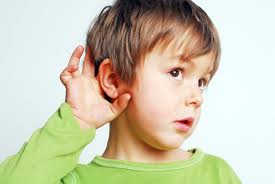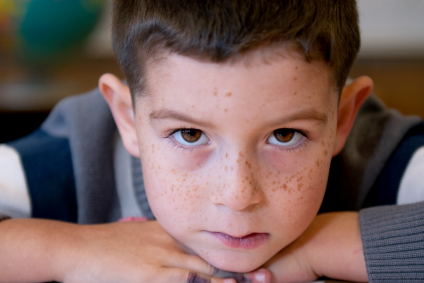
by PRIDE Reading Program Admin | Jan 28, 2015 | A PRIDE Post, Auditory Processing Disorder
If your child has auditory processing and finds it difficult to concentrate and retain information, here are a few fun activities that you and your child can do together that will target and improve auditory processing skills:
Practice sequencing with sounds
Ask your child to cover his eyes with his hands while you make a noise such as closing the door, sneezing, or playing a key on the piano. Have your child first identify the noise. Then try two noises, one after the other. Your child will then identify the two sounds in sequence. Add the number of sounds in the sequence until your child gets tired with the game. Some ideas for noises are:
- Whistling
- Snapping fingers
- Sharpening a pencil
- Hammering
- Tearing paper
- Slamming a book closed
- Ringing a bell
- Blowing a whistle
- Clapping
- Coughing
- Drumming with fingers
- Hammering
- Crumpling paper
- Unwrapping candy
Name the mistake
Recite or read aloud a familiar text, poem or rhyme changing its words or wording. Your child should raise his hand whenever an error occurs. You can change the words, grammar, phonemes and meaning. Also, you can swap word order or word parts. Here are a few examples:
- Once a time upon…
- Old McDonald had a fern…
- Twinkle, twinkle little car…
Clapping syllables
Start out by pronouncing each family member’s name by clapping it syllable by syllable. Then ask your child to say and clap the name along with you. Each clap represents a syllable or word part. After each name has been clapped ask, “how many syllables did you hear?” You can also have your child place two fingers under her chin, so that she can feel her chin drop for each syllable. This also allows your child to feel the vibration of each syllable.
Sound substitution
In this activity, your child will make new words by replacing the first sound in the word with the target sound. For example, target the phoneme /l/. Ask your child to substitute the /h/ in ‘hand’ with /l/. The word now becomes ‘land.’
Sound sort
Make picture cards using magazines or computer art. Glue the pictures on index cards and laminate them if you can. Spread selected pictures in front of your child and ask him to find the picture whose name starts with a certain sound. As each picture is found, have your child name the picture and the initial sound. For example you can say, “what picture begins with the sound /s/?” Your child might respond “Snake, /s/.” Examples of some pictures include:
Picture guess
Using the same pictures, place them in a bag. Pick out a picture from the bag and don’t show it to your child. Pronounce the name of the picture, phoneme by phoneme. For a picture of a cat, you will say /c/ /a/ /t/. Then your son guesses what the picture is from your isolated sounds. Take turns guessing each other’s pictures.
Listen for sounds
Have your child sit on the floor, close his eyes and identify sounds that you make. You can drop a pencil, bounce a ball, tap on the window, use a stapler, cut with scissors, sip on a cup of coffee or type on your computer. Trade roles and then let the child make different sounds that you have to identify.
Outside noises
Sit outside under a tree with your child. Listen for various sounds like birds chirping, airplanes flying overhead, cars driving by, voices of children playing are pretty fun to identify. You can have a little notebook on hand and keep a list of all of the different sounds you come across.
Repeat after me
Sit across from your child and clap your hands to a rhythmic pattern alternating between slow and fast tempos. Have your child repeat the pattern. You can also use various instruments, play a drum or bounce a ball to a variety of rhythms. Switch roles and let your child be the sound leader as well.
Hide and seek
Hide a metronome or a ticking clock somewhere in your home. Have your child find it by locating the sound. Another variation of this game can be played outside. You can hide somewhere and blow a whistle. The child will then follow the sounds to find where you are hiding.
Read rhyming books
Repetitive rhyming books help children listen carefully to the similar sounds of rhyming words. Some great rhyming books are “Hop on Pop”, “Fox in Socks”, Goose on the Loose” and “Goodnight Moon.”
Sing songs
Sing songs together that involve repeating previous verses, such as “Old MacDonald Had a Farm”, “Over in the River”, “The Twelve Days of Christmas” and “The Green Grass Grows All Around.”
Practice focusing
Read a very simple story to your child with soft music playing in the background. Before reading the story, tell your child to listen for specific pieces of information in the story (for example the main characters name). You can gradually increase the difficulty of the information you want your child to listen for.
Comprehension check
Read an unfamiliar story to your child. Afterwards ask your child questions about the sequence of events. What happened first, who went to the game, etc. Continue to ask questions until the events in the story have been reviewed. You can also ask your child to predict likely events in the story.
Karina Richland, M.A., is the Founder of PRIDE Learning Centers, located in Los Angeles and Orange County. Ms. Richland is a certified reading and learning disability specialist. Ms. Richland speaks frequently to parents, teachers, and professionals on learning differences, and writes for several journals and publications. You can reach her by email at karina@pridelearningcenter.com or visit the PRIDE Learning Center website at: www.pridelearningcenter.com

by PRIDE Reading Program Admin | Jan 12, 2015 | Auditory Processing Disorder, Pride Orange County
An Orange County tutoring center is offering help for kids that have auditory processing disorder.
Children with auditory processing will often struggle in a classroom setting, especially in the areas of reading, comprehension and language skills. These children are unable to process the information they hear in the same way as others because something adversely affects the way their brain recognizes and interprets sounds, most notably the sounds composing speech.
“Auditory processing disorder affects about 5% of school-age children,” says Karina Richland, owner of PRIDE Learning Centers. “Reading and comprehension are very difficult for children diagnosed with auditory processing and these children end up struggling so much in school because of it.”
PRIDE Learning Center teaches children with auditory processing disorder how to read, write and comprehend using a multisensory method called the Orton-Gillingham approach. It is an intensive one-on-one reading program that stresses teaching the entire structure of written English through a systemized teaching of letters and their corresponding sounds.
“The Orton-Gillingham approach is highly successful for kids struggling with auditory processing because it is so structured, repetitious and multisensory,” says Richland. “ Our kids use all of their senses when they learn and are therefore better able to store and retrieve the information. A child, for example might see the letter B, say its name and sound, and write it in the air all at the same time.”
All of the reading specialists at PRIDE Learning Center are credentialed teachers with strong special education backgrounds and are Orton-Gillingham Certified.
PRIDE Learning Centers are located in Mission Viejo, Newport Beach and San Clemente. For more information contact May Dabbah at 949-484-0230 or visit the website at www.pridelearningcenter.com

by PRIDE Reading Program Admin | Jan 12, 2015 | Auditory Processing Disorder, Pride Redondo Beach
A Redondo Beach tutoring center is offering help for kids that have been diagnosed with auditory processing disorder.
Children with auditory processing will often struggle in a classroom setting, especially in the areas of reading, comprehension and language skills. These children are unable to process the information they hear in the same way as others because something adversely affects the way their brain recognizes and interprets sounds, most notably the sounds composing speech.
“Auditory processing disorder affects about 5% of school-age children,” says Karina Richland, owner of PRIDE Learning Center in Redondo Beach. “Reading and comprehension are very difficult for children diagnosed with auditory processing and these children end up struggling so much in school because of it.”
PRIDE Learning Center teaches children with auditory processing disorder how to read write and comprehend using a multisensory method called the Orton-Gillingham approach. It is an intensive one-on-one reading program that stresses teaching the entire structure of written English through a systemized teaching of letters and their corresponding sounds.
“The Orton-Gillingham approach is highly successful for kids struggling with auditory processing because it is so structured, repetitious and multisensory,” says Richland. “ Our kids use all of their senses when they learn and are therefore better able to store and retrieve the information. A child, for example might see the letter B, say its name and sound, and write it in the air all at the same time.”
All of the reading specialists at PRIDE Learning Center are credentialed teachers with strong special education backgrounds and are Orton-Gillingham Certified.
PRIDE Learning Center is located at 1603 Aviation Blvd., Suite G in Redondo Beach, CA. For more information contact Christine McLarty at 310-322-2800 or visit the website at www.pridelearningcenter.com

by PRIDE Reading Program Admin | Aug 23, 2011 | A PRIDE Post, Auditory Processing Disorder
By Karina Richland, M.A., E.T.
- Is your child easily distracted or bothered by loud or sudden noises?
- Are conversations difficult for your child to follow?
- Are noisy environments upsetting?
- Are verbal (word) math problems demanding?
- Does your child have difficulty following directions?
- Is abstract information tough to interpret?
- Does your child struggle with reading, spelling, writing, or other speech-related language difficulties?
Central auditory processing disorder (CAPD) occurs when the ear and the brain do not coordinate together completely. Many of the behaviors associated with central auditory processing disorder also appear in other conditions such as learning disabilities (LD) and attention deficit disorder (ADHD). The symptoms in each individual can range from mild to severe and only a trained professional, such as a speech-language pathologists and an audiologist who specialize in CAPD, can determine if your child actually has a central auditory processing disorder.
If your child does have central auditory processing disorder and finds it difficult to concentrate and follow directions, there are numerous strategies that parents can implement for their child.
What was I supposed to do again?
In order to help a child with CAPD follow directions, try reducing background noises, always have the child look at you when you are speaking and use simple, expressive sentences. Speaking at a slightly louder volume and at a slower tempo will also help significantly. Have your child repeat the directions back to you aloud a few times and be certain that they understand the directions they are repeating and not just mimicking your voice.
I left my book at school.
A student with CAPD will thrive on routine and structure. Teach your child how to focus and cope in chaotic environments (like middle school). Before going home for the day, for instance, have the child check his or her assignment book and list what he or she needs to take home that day.
I can’t concentrate; it’s too loud in here.
At school the child should sit towards the front of the room facing the teacher with his or her back to the windows, doors, and other sources of distraction. The teacher can periodically touch the child’s shoulder to remind him or her to focus or get ready for a transition. Teachers should use lots and lots of visual aids jotting down instructions or key words on the board, and providing simple written outlines. For younger students a drawing works fine as a reminder.
At home, provide the child with a quiet study place. Keep the TV turned off and any outside stimuli far away. Make sure the work desk is free of clutter and well organized. Maintain a peaceful, organized lifestyle that also encourages good eating and sleeping habits and keeping a neat room and desk.
Teachers and parents both need to remember that central auditory processing disorder is a real condition. The symptoms and behaviors are not within the child’s control. Children with CAPD are not being defiant or being lazy. Help them build a strong self-esteem and learn to advocate for themselves, as they get older. Keep it positive and keep life fun!
__________________________________________________________________________________________
Karina Richland, M.A., E.T. is the Managing Director of Pride Learning Centers, located in Los Angeles and Orange County. A former teacher for Los Angeles Unified School District, Ms. Richland is a Reading and Learning Disability Specialist. Ms. Richland speaks frequently to parents, teachers, and professionals on learning differences, and writes for several journals and publications. You can reach her by email at: info@pridelearningcenter.com or visit the Pride Learning Center website at:
www.pridelearningcenter.com

by PRIDE Reading Program Admin | Feb 22, 2011 | A PRIDE Post, Auditory Processing Disorder, Autism
Many of our students at Pride Learning Center have been diagnosed with auditory processing difficulties due to CAPD, ADHD, dyslexia, autism, or a learning disability. Often parents will ask me the question, “what can I do at home to help?” I have composed a list of activities that strengthen and support auditory processing deficits that are simple, quick and easy to incorporate at home.
a
1. Listen for Sounds. Have your child sit at your desk, close their eyes and identify sounds that you make. You can drop a pencil, bounce a ball, tap on the window, tear a paper, use a stapler, cut with scissors, open the door, type on your computer, sip a cup of coffee or write with a marker. Trade roles and then let the child make different sounds that you have to identify.
2. Take a Nature Walk. Sit outside under a tree and listen for various sounds outside of the house. Sounds like birds chirping, airplanes flying overhead, cars driving by, voices of children playing are fun to identify. You can have a little notebook on hand and keep a list of all of the different sounds you came across.
3. Repeat a Pattern. Sit across from your child and clap your hands to a rhythmic pattern alternating between slow and fast tempos. Have your child repeat the pattern. You can also use various instruments, play a drum or bounce a ball to a variety of rhythms. Switch roles and let your child be the sound leader as well.
4. Hide and Seek. Hide a metronome or a ticking clock somewhere in your home. Have your child find it by locating the sound. Another variation of this game can be played outside. You can hide somewhere and blow a whistle. The child will then follow the sounds to find where you are hiding.
5. Sing Songs. Sing songs together that involve repeating previous verses, such as “Old MacDonald Had a Farm”, “Over in the River”, “The Twelve Days of Christmas” and “The Green Grass Grows All Around.”
6. Read Rhyming Books Together. For beginning readers, repetitive and rhyming books help children listen carefully to the similar sounds of rhyming words. Some great rhyming books are “Hop on Pop”, “Fox in Socks”, “Goose on the Loose” and “Goodnight Moon.”
____________________________________________________________________________________
Karina Richland, M.A., E.T. is the Managing Director of Pride Learning Centers, located in Los Angeles and Orange County. A former teacher for Los Angeles Unified School District, Ms. Richland is a reading and learning disability specialist. Ms. Richland speaks frequently to parents, teachers, and professionals on learning differences, and writes for several journals and publications. You can reach her by email at karina@pridelearningcenter.com or visit the Pride Learning Center website at: www.pridelearningcenter.com





